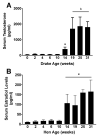Ontogeny of OPN4, OPN5, GnRH and GnIH mRNA Expression in the Posthatch Male and Female Pekin Duck (Anas platyrhynchos domesticus) Suggests OPN4 May Have Additional Functions beyond Reproduction
- PMID: 33919914
- PMCID: PMC8070892
- DOI: 10.3390/ani11041121
Ontogeny of OPN4, OPN5, GnRH and GnIH mRNA Expression in the Posthatch Male and Female Pekin Duck (Anas platyrhynchos domesticus) Suggests OPN4 May Have Additional Functions beyond Reproduction
Abstract
The hypothalamic-pituitary-gonadal axis (HPG) is known to be regulated by daylength through the deep brain photoreceptor (DBP) system. The post-hatch ontogeny is not known for any of the DBPs. We set out to determine the ontogeny of OPN4 and OPN5 gene expression relative to GnRH and GnIH using qRT-PCR. Brains and serum were collected from five drakes and five hens on the day of hatching (Day 0) and again at 2, 4, 6, 10, 14, 19, 25 and 31 weeks of age and analyzed by qRT-PCR. Hen and drake serum was assayed for circulating levels of estradiol and testosterone, respectively. Data were analyzed between sexes over time using a repeated measures two-way ANOVA. Interestingly, the results show that on the day of hatching (Day 0), ducks showed adult-like levels of relative OPN4, but not OPN5, gene expression. During week 10, DBP levels increased, achieving highest relative expression levels at week 19 that maintained through week 31, typically peak fertility in ducks. GnRH mRNA levels increased following the DBP expression at the onset of puberty, and gonadal steroids increased after GnRH at week 14 while estradiol preceded testosterone. GnIH mRNA levels did not appreciably change during the time course of this experiment. These observations suggest that OPN4 may be active during the peri-hatch period and may have physiological roles beyond puberty and fertility.
Keywords: melanopsin; neonate; photoreception; puberty.
Conflict of interest statement
The authors have no conflict to report.
Figures


Similar articles
-
Immunolesion of melanopsin neurons causes gonadal regression in Pekin drakes (Anas platyrhynchos domesticus).Gen Comp Endocrinol. 2018 Jan 15;256:16-22. doi: 10.1016/j.ygcen.2017.08.006. Epub 2017 Aug 4. Gen Comp Endocrinol. 2018. PMID: 28782536
-
Deep-brain photoreceptors (DBPs) involved in the photoperiodic gonadal response in an avian species, Gallus gallus.Gen Comp Endocrinol. 2015 Jan 15;211:106-13. doi: 10.1016/j.ygcen.2014.11.020. Epub 2014 Dec 5. Gen Comp Endocrinol. 2015. PMID: 25486342
-
Expression of deep brain photoreceptors in the Pekin drake: a possible role in the maintenance of testicular function.Poult Sci. 2017 Aug 1;96(8):2908-2919. doi: 10.3382/ps/pex037. Poult Sci. 2017. PMID: 28339754 Free PMC article.
-
Should I Lay or Should I Grow: Photoperiodic Versus Metabolic Cues in Chickens.Front Physiol. 2020 Jun 26;11:707. doi: 10.3389/fphys.2020.00707. eCollection 2020. Front Physiol. 2020. PMID: 32670092 Free PMC article. Review.
-
Reproductive Neuroendocrine Pathways of Social Behavior.Front Endocrinol (Lausanne). 2016 Mar 31;7:28. doi: 10.3389/fendo.2016.00028. eCollection 2016. Front Endocrinol (Lausanne). 2016. PMID: 27065948 Free PMC article. Review.
Cited by
-
Photostimulation decreases fearfulness, but improves growth performance and egg quality of breeder Pekin ducks.Poult Sci. 2025 Jan;104(1):104563. doi: 10.1016/j.psj.2024.104563. Epub 2024 Nov 22. Poult Sci. 2025. PMID: 39608283 Free PMC article.
-
The Impacts of Female Access during Rearing on the Reproductive Behavior and Physiology of Pekin Drakes, and Flock Fertility.Animals (Basel). 2022 Oct 29;12(21):2979. doi: 10.3390/ani12212979. Animals (Basel). 2022. PMID: 36359103 Free PMC article.
-
Variation in DNA Methylation in Avian Nestlings Is Largely Determined by Genetic Effects.Mol Biol Evol. 2023 Apr 4;40(4):msad086. doi: 10.1093/molbev/msad086. Mol Biol Evol. 2023. PMID: 37039566 Free PMC article.
-
Central Nervous System Associated With Light Perception and Physiological Responses of Birds.Front Physiol. 2021 Oct 21;12:723454. doi: 10.3389/fphys.2021.723454. eCollection 2021. Front Physiol. 2021. PMID: 34744764 Free PMC article.
-
Pulsed alternating wavelength system lighting does not negatively impact production or welfare but reduces dopamine activity and may improve bone growth in grow-out Pekin ducks: Effects of PAWS lighting on meat ducks.Poult Sci. 2025 Mar;104(3):104853. doi: 10.1016/j.psj.2025.104853. Epub 2025 Jan 23. Poult Sci. 2025. PMID: 39923454 Free PMC article.
References
-
- Benoit J., Assenmacher I., Walter F.X. Gonadotropic activity of the hypophysis of the domestic duck during seasonal testicular regression and prepuberty. C. R. Seances. Soc. Biol. Fil. 1950;144:1403–1407. - PubMed
-
- Benoit J., Assenmacher I., Brard E. Action of prolonged permanent lighting on the testicular development of the Pekin duck. Arch. Anat. Microsc. Morphol. Exp. 1959;48:5–11. - PubMed
-
- Benoit J., Assenmacher I. Hypothalamo-hypophyseal relationship and its role in gonadostimulation in domestic duck. J. Physiol. 1951;43:643–645. - PubMed
Grants and funding
LinkOut - more resources
Full Text Sources
Other Literature Sources

